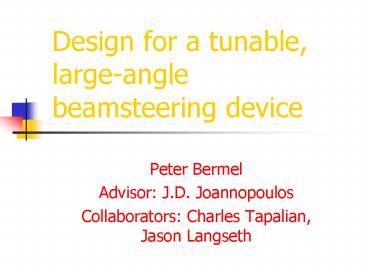Design for a tunable, largeangle beamsteering device - PowerPoint PPT Presentation
Title:
Design for a tunable, largeangle beamsteering device
Description:
Design for a tunable, largeangle beamsteering device – PowerPoint PPT presentation
Number of Views:88
Avg rating:3.0/5.0
Title: Design for a tunable, largeangle beamsteering device
1
Design for a tunable, large-angle beamsteering
device
- Peter Bermel
- Advisor J.D. Joannopoulos
- Collaborators Charles Tapalian, Jason Langseth
2
Outline
- Introduction
- Refractive index modulation
- Slow light
- Design for enhancing phase modulation
- Beam-steering applications
- Future directions
- Conclusions
3
Refractive index modulation
- Definition changing refractive index of material
in controlled fashion - Motivation controlling phase, amplitude of light
- Potential devices
- Beam steering devices
- Optical phased arrays
- Materials
- Electro-optic materials (e.g., organic-doped
solgels, PLZT)
4
Refractive index modulation
- Two ways to enhance index modulation
- Material choice (limited capabilities)
- Structural design
- Structural approach necessary to achieve complete
control of interference (i.e., Df2p) - comes about from slowing down light (using PhCs)
5
Photonic crystals slow light
- Periodic dielectric media reflect certain
wavelengths and transmit others - Can slow down light through weakly coupled
cavities, e.g., periodic defects in a 1D photonic
crystal
6
Photonic crystals slow light
? Total savings O((vG/c)2)
7
Structural enhancement
- Single element design
- Non-linear material in middle
- Controlled by transparent oxide electrodes
- Photonic crystal enhancing non-linear effects
8
Structural enhancement
- Can calculate exact phase shift for PhC cavity
- For large Q, simplifies to
- Expect polarization-insensitive enhancement of
index modulation that can be increased up to p
(maximum phase shift through resonance) - For m resonances, maximum phase shift is mp
9
Structural enhancement
- For full phase control, use two resonances
- Shift indices of non-linear material only to make
all half-maxima coincide - Each point at half-maximum will be p/2 out of
phase with the next
10
Conceptual vision
- Photonic Crystal array
- Contain non-linear materials driven by
transparent electrodes - Placed between PhCs to slow down light, enhancing
phase modulation - Interference between devices can lead to true 2p
solid angle beamsteering
11
Conceptual vision
- Advantages of photonic crystal beam steering
- Large angle steering only requires single stage
- Switchable at very high speed (110 GHz)
- Polarization-insensitive
- Common aperture device
12
Beam-steering
- Simulated structure
- Dual resonances
- 3 exterior, 1 interior photonic crystal bilayers
of indices n2.87 and n1.8 - Index change of 8 required (can be decreased by
increasing Q)
13
Beam-steering
- Behavior with non-linearities turned off
- No beamsteering occurs
14
Beam-steering
- Behavior with non-linearities turned on
- Beam is steered to an angle of 52º!
15
Beam-steering
- Can switch between straight and large-angle
propagation using non-linear materials photonic
crystals
Straight propagation with non-linearities off
52 degree propagation with non-linearities on
16
Future directions
- Experimental work on photonic crystal beam
steering devices - Fabrication
- Characterization
- Full 3-D modeling of experimental systems
- Common aperture showing that the reciprocal beam
is directed at the same angle - Modulation of multiple, discrete wavelengths
- Constant phase modulation from any angle or
polarization
17
Conclusions
- Refractive index effects are often too weak to
achieve maximum phase modulation - Slowing down light can amplify these effects to
useful levels - Can design practical, large-angle beam-steering
devices - Prototype beam-steering devices based on this
design can be fabricated and characterized in the
laboratory































